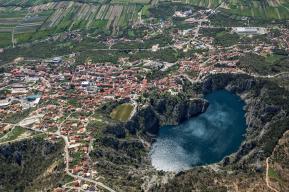مقال
العناية بحوتيات نهر اليانغتسي

منذ وفاة بايجي سنة 2002، آخر ممثّل لدلافين المياه العذبة لنهر اليانغتسي، أصبح هذا الجنس في عداد الأجناس المنقرضة. وتُبذل الآن جهود عديدة لإنقاذ جنس آخر من حوتيات النهر، ألا وهو خنزير البحر اللازعنفي أو عديم الزّعانف.
وانغ دينغ
أستاذ بمعهد علم الأحياء المائية التابع للأكاديمية الصينية للعلوم، عضو مجموعة الأخصّائيين في الحوتيات التابعة للجنة المحافظة على الأجناس صلب الاتحاد الدولي لحفظ الطبيعة CSE/UICN، وعضو اللجنة الوطنية الصينية التابعة لبرنامج ديفارسيتاس الدّولي. وهو أيضًا الأمين العام للجنة الوطنية الصينية لبرنامج الإنسان والمحيط الحيوي MAB التابع لليونسكو.
في إطار الوظائف التي أمارسها منذ سنة 1982 في معهد علم الأحياء المائية بووهان، عملت لمدة عشرين سنة جنب تشي تشي، دلفين اليانغتسي الوحيد الذي يعيش في الأسر في العالم: ليبوتز فاكسيليفر Lipotes vexillifer ("حامل العلم المنسي")، أو بايجي باللغة الصينية.
ففي سنة 1980، تم القبض، صدفة، على تشي تشي من طرف صيادين، وكان سنّه عامين، وتمّت معالجته في حوض الدّلافين بووهان حيث عاش لمدة تزيد عن عقدين من الزّمن. وقد مثّلت وفاة هذه "الأحفورة الحيّة" سنة 2002، بحكم الشّيخوخة، صدمة بالنسبة إلي، إذ لم أستطع قبول فكرة أن يُعرَّف هذا الجنس، من هنا فصاعدا، بأنّه "جنس منقرض"، وهو الذي عاش في نهر اليانغتسي طيلة أكثر من 20 مليون سنة.
كان بايجي يحظى بالإجلال والإكرام باعتباره "إله ليانغتسي"، وقد ورد اسمه منذ سنة 200 قبل الميلاد في الـ"آريا"، أقدم قاموس صيني. ولم يزد ذلك سوى من عزمنا وتصميمنا على حماية نظراء تشي تشي قبل انقراضهم تماما. والمؤسف أنّنا اكتشفنا أن الوقت قد فات.
جنس فريد من دلفين المياه العذبة
تولّيت، سنة 2006، قيادة رحلة استكشافية لمدة 39 يومًا للبحث عن آخر ما تبقّى من دلفين البايجي في نهر اليانغتسي. كان الفريق مكوّنا من حوالي 60 أخصائيا في علم الأحياء البحرية من الدرجة الأولى– قدموا من الصين واليابان وسويسرا وألمانيا والمملكة المتحدة وكندا والولايات المتحدة الأمريكية – وبادروا بتطبيق تقنيات الكشف الأكثر تقدمًا في تلك الفترة، دون التمكّن من العثور على بايجي واحد. وبعد سنة، أُعلن هذا الجنس أنّه "منقرض وظيفيًا" من قبل مجلة رسائل علم الأحياء Biology Letters الصّادرة عن المؤسسة الملكية لعلم الأحياء بالمملكة المتحدة.
ورغم ما يرد علينا من أرصاد غير مؤكّدة للبايجي، فإن الأمل ضعيف جدا في أن يعود يوما ما ذلك الدلفين طويل الأنف الذي يعتمد على صدى الصوت أكثر من المشاهدة بالعينين للتّنقل في مياه النهر العكرة.
هذا الجنس الفريد من دلفين المياه العذبة، الذي يضفي عليه الصيادون والملّاحون القدرة على حمايتهم على طول ممر الملاحة الرّابط لوسط الصّين بالمحيط الهادئ والبالغ طوله 1700 كيلومتر، لم يكن موجودًا سوى في المجاري الفرعية الوسطى والدّنيا لنهر اليانغتسي وفي البحيرات الكبرى لحوض النّهر.
واعتمادا على إحصائيات غير مكتملة، فإن النّشاط البشري مسؤول عن%90 من وفيّات البايجي المعروفة قبل سنة 1985. فالصّيد الصناعي، والصّيد الجائر غير القانوني والضّار، والنمّو المتزايد للسّفن الحاملة للحاويات، وبوارج الفحم، والقوارب السّريعة، تعتبر جميعها الأسباب الرئيسية للانخفاض الكبير في أعداد دلافين المياه العذبة وانخفاض مساحة انتشارها خلال العقود الأخيرة.
وعلى الصّعيد العلمي، تُعدُّ دلافين المياه العذبة مؤشّرا حاسما يُوفّر معلوماتٍ عن حالة التنوّع البيولوجي في الأنهار وتطوّره.
"نهر الحياة" يجب حمايته
هناك جنس آخر من الحيتان، وهو خنزير البحر اللازعنفي أو عديم الزّعانف، يشترك مع البايجي في نفس الصّنف من الموائل، ويتعرّض بالتالي إلى نفس التّهديدات، ويُعرف أيضا باسم "عروس أو جِنيّة يانغتسي". هذه الحيتان الصغيرة، بحجم حوض استحمام منزلي، والتي ليس لها زعنفة ظهرية حقيقية بل مجرّد عرف صغير على ظهرها، مُدرجة في القائمة الحمراء للأجناس المهددة جديّا بالانقراض التابعة للاتّحاد الدولي لحفظ الطّبيعة. فلقد انخفض عددها بسرعة، حيث لم يبق منها، سنة 2017، رغم جهود الحفظ، سوى 1012 كائن يعيش في الطبيعة.
ومع ذلك، فقد تحسّنت الإدارة البيئية للحكومات المحلّية بشكل ملحوظ في العقود الأخيرة. ولئن كانت التّنمية الاقتصادية تُمثّل الأولويّة في الصّين خلال الثمانينيات، فلقد أصبحت الحكومة والسّلطات المحلية منذ ذلك الحين تدرك شيئا فشيئا تأثيرها على البيئة واتّخذت اجراءات وقائيّة في هذا الصّدد.
يُعدّ نهر اليانغتسي ثالث نهر في العالم، وأطول نهر يشقّ دولة واحدة، فمن البديهي أن يُعرف بـ"نهر الحياة". ولأنه يُمثّل %40 من المياه العذبة الصينية، فهو مصدر رزق لملايين البشر، وكذلك للحيوانات البرّية مثل سمك الحفش الصيني، والقرد أفطس الأنف، والباندا العملاقة. ولئن يمتدّ حوض تصريف مياه اليانغستي (أو مستجمعه المائي) على خُمُسِ مساحة البلاد، فإنّ محصوله قد يصل إلى حدود ثُلث النّاتج المحلّي الخام للبلاد.
ولاستعادة النظام البيئي والحفاظ على التنوّع البيولوجي، صدر في يناير 2021 قرار بوقف الصّيد البحري لمدّة عشر سنوات في جميع الممرّات الملاحية الطبيعية لنهر اليانغتسي. ولقد دخل قانون حماية نهر اليانغتسي حيز التّنفيذ بعد شهرين من ذلك، في مارس، مما زاد في تعزيز حماية حوض النّهر وإعادة تأهيله البيئي. وعلاوة عن دعمه لتنفيذ منع الصيد البحري على المستوى التّشريعي، يؤكّد هذا القانون الجديد على ضرورة إيجاد تنمية اجتماعية واقتصادية مستدامة.
وضعية حفظ رفيعة المستوى
كما تمّ إنشاء تسع محميّات طبيعيّة وطنيّة ومحليّة - بعضها يشمل أجزاء من نهر اليانغتسي ومحميّات شبه طبيعية خارج الموقع - على طول النّهر للحفاظ على دلافين المياه العذبة. فمحميّة تيانزهو الطبيعيّة، التي أُنشئت في القرن الماضي، وهي بحيرة يبلغ طولها 21 كيلومترًا تشكّلت داخل لسان ميت للنّهر وتعرف بـ "اليانغتسي المصغّر"، كان يُفترض أن تكون ملاذًا لدلافين البايجي. فهي تقع بالقرب من مدينة شيشوا في مقاطعة هوباي، وتأوي اليوم حوالي 100 من خنازير البحر اللازعنفية التي تستفيد من نفس إجراءات الحفظ خارج الموقع بعد أن كانت مخصصّة، في الأصل، لدلفين اليانغتسي.
في خضم اندفاع كبير لإنقاذ هذه الثدييّات المهدّدة جدّيا بالانقراض، رفّعت الحكومة الصّينية في فبراير 2021 في درجة حماية خنازير البحر اللاّزعنفية في نهر اليانغتسي حيث أصبحت تُصنّف في فئة "الأجناس الوطنية المحمية من المستوى الأول"، وهي أعلى حماية في البلاد للحيوانات البريّة.
اليوم، وبعد ما يُقارب العشرين سنة من اختفاء التشي تشي، تعمل حوالي 20 منظمة غير حكومية على حماية ابن عمه الصغير. وقد تمّ تشجيع الجمهور على المشاركة حيث يقوم المتطوّعون المحلّيون بدوريّات، ليلا ونهارا، على طول المجاري الفرعيّة الوسطى والسّفلى للنّهر، وكذلك في منطقة بحيرتيْ بويانغ ودونغتينغ، لحماية خنازير البحر اللاّزعنفية.
كما تُبذَل الجهود من أجل دعم الثّقافات المحليّة غير الماديّة، للحفاظ على ذاكرة السكّان، وصون الثقافة التقليدية (في شكل حكايات وأساطير) وحماية المعارف البيئية المتعلّقة بالبيجي. ويشكّل تاريخ التشي تشي وحكايته موضوع منشورات يقرأها الأطفال في جميع أنحاء الصّين. وأنا كلّي أمل في أن تبقى ذكرى هذه الدّلافين الأنيقة، والتي لا مثيل لها، منحوتة في الذّاكرة إلى الأبد.
مطالعات ذات صلة
مدارس المياه تسهر على سلامة نهر اليانغتسي، رسالة اليونسكو، أبريل 2009
نهر اليانغتسي أو رحلة عبر الزمن، رسالة اليونسكو، مارس 2009
اشترك في رسالة اليونسكو لمتابعة الأحداث. الاشتراك في النسخة الرقمية مجاني %100.
By Wang Ding
As part of my work at the Institute of Hydrobiology in Wuhan since 1982, I spent twenty years with Qi Qi [pronounced chee-chee], the world’s only captive baiji Yangtze River Dolphin (Lipotes vexillifer, “the flag-bearer who was left behind”).
Rescued from a fisherman’s net in 1980 after he had been accidentally hunted when he was only 2 years old, the injured Qi Qi lived in the Wuhan Dolphinarium for over two decades. The death of this “living fossil” from old age in 2002 was an emotional blow, personally. I couldn’t accept that the species, which is believed to have flourished in the Yangtze for over 20 million years, could soon be labelled “extinct”.
The death of this ‘living fossil’ was an emotional blow, personally
Revered in China as the “goddess of the Yangtze”, the baiji has been described in the Erya, the oldest surviving Chinese dictionary, dating back to 200 BC. This only strengthened our resolve to protect Qi Qi’s fellow creatures before they completely disappeared. Unfortunately, we found that it was already too late.
A unique species
In 2006, I led a thirty-nine-day expedition to search the Yangtze River for any trace of the last remaining baiji. A team of over sixty leading marine biologists – from China, Japan, Switzerland, Germany, the United Kingdom, Canada, and the United States – used the most advanced detection techniques available at the time, but failed to find a single baiji. A year later, the graceful creature was declared functionally extinct by Biology Letters of the Royal Society of Biology, UK.
Even though unconfirmed sightings of the baiji continue to be reported, there is very little chance that this long-snouted dolphin – that relies on sonar rather than on its eyes to navigate the murky river waters – will ever be found again.
This unique freshwater dolphin, who was believed to protect fishermen and boatmen along the 1,700-kilometre waterway from central China all the way to the Pacific in ancient times, was found only in the middle and lower reaches of the Yangtze, and its connected big lakes.
According to incomplete statistics, human activity was to blame for ninety per cent of known baiji deaths before 1985. Industrialized fishing, illegal and harmful overfishing, and the unbridled growth of container ships, coal barges and speed-boats are the main causes of the river dolphin’s population decline and range contraction during the last several decades.
Scientifically speaking, the role of river dolphins as an indicator is particularly important because it can be used to monitor the status and trends of freshwater biodiversity in rivers.
The death of this ‘living fossil’ was an emotional blow, personally
Protecting the “river of life”
Another cetacean in the Yangtze, the finless porpoise (Neophocaena asiaeorientalis ssp. asiaeorientalis), shares almost the same habitats as the baiji, and therefore faces the same threats. Also known as “Yangtze mermaids”, these smaller bath-tub-sized cetaceans – which lack a proper dorsal fin and have a small dorsal ridge on their backs instead – have been listed as critically endangered on the International Union for Conservation of Nature’s IUCN Red List. Their number has been decreasing rapidly – with only 1,012 individuals still living in the wild in 2017, in spite of conservation efforts.
There is hope, however. Over the past few decades, the environmental management of local governments has improved significantly. While China’s economic development took priority in the 1980s, the government and local authorities began to realize its environmental impact in the decades that followed, and have started to take measures to protect the environment.
The longest river running through only one country, and the third-longest in the world, the Yangtze is known as the “river of life” for obvious reasons. Accounting for forty per cent of China’s fresh water, it is literally the source of life for millions of people, and wildlife such as ancient sturgeon, snub-nosed monkeys and giant pandas. Its drainage basin comprises only a fifth of China’s land area, but generates as much as one-third of China’s gross domestic product (GDP).
To restore the ecosystem and to preserve biodiversity, a ten-year fishing moratorium in all the natural waterways along the Yangtze River was introduced in January 2021. Two months later, in March, the Yangtze River Protection Law came into effect, further strengthening the ecological protection and restoration of the river basin. Besides promoting the implementation of the fishing ban at the legislative level, the new law emphasizes the need for sustainable socio-economic development at the national and regional levels.
To restore the ecosystem, a ten-year fishing moratorium was introduced along the Yangtze
An elevated conservation status
Nine national and local nature reserves – some of them comprising river sections and semi-natural ex situ reserves – have also been established along the river for the conservation of freshwater dolphins. Originally established as a sanctuary for the baiji in the last century, the Tian-e-Zhou Oxbow Nature Reserve – a twenty-one kilometre oxbow lake described as “a miniature Yangtze” – an area of wetlands near Shishou in Hubei province, now holds approximately 100 finless porpoises. These creatures profit from ex situ conservation measures originally designed for the baiji.
In a major boost for the critically endangered mammals, the Chinese government upgraded the protection of Yangtze finless porpoises in February 2021, to national first-level protected species – the country’s highest level of protection for wild animals.
Today, nearly twenty years since Qi Qi died, over twenty non-governmental organizations (NGOs) are involved in the protection of its smaller cousin. The participation of the public has been encouraged, with local volunteers patrolling day and night along the middle and lower reaches of the river, and in the Poyang and Dongting Lake areas, to protect finless porpoises.
In a bid to preserve intangible local culture, efforts are being made to ensure that the local memory, traditional culture in the form of Chinese legends and folktales, and ecological knowledge of the baiji are kept alive. Stories about Qi Qi are published and read by children across China. I am hopeful that memories of these unique and elegant dolphins will remain forever.
Wang Ding
Professor at the Institute of Hydrobiology (HIB) of the Chinese Academy of Sciences, he is a member of the International Union for Conservation of Nature Species Survival Commission (IUCN-SSC) Cetacean Specialist Group, and the Chinese National Committee for DIVERSITAS.

In the same issue










